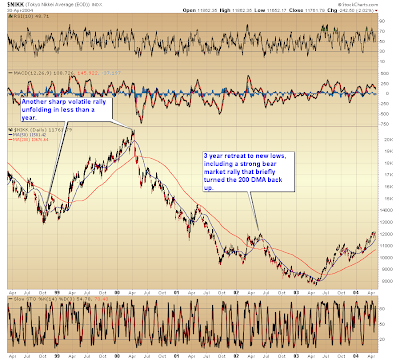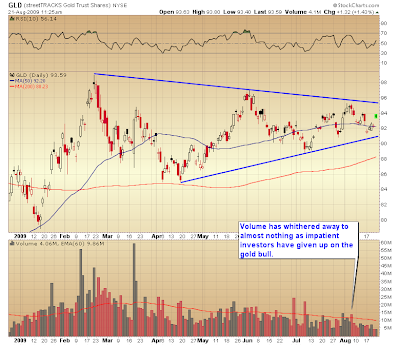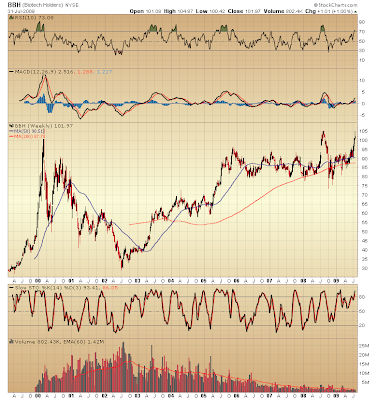Today I’m going to share some of the goofs and blunders that I’ve made over the years and hopefully keep some of you from making the same mistakes.
Number one on the list. Trading too large.
Without a doubt this is the single biggest mistake that everyone makes when they start investing (and continue to make throughout their career). It is also the one mistake that is guaranteed to ruin ones account. The problem with trading a large position comes if you get lucky and win, especially if it happens very early in your trading career. I know that sounds counter intuitive but here’s what happens when you make a huge bet and win. You get cocky and think it’s easy to get rich in the stock market. You become convinced you are smarter than everyone else and have the market “wired”.
So instead of putting your winnings in your pocket and going home you stay at the table. Does anyone know what happens if you stay at the casino long enough? That’s right you lose your money. In the casino you lose because the odds are against you. In the stock market you lose because you took on too much risk. No matter how good you are, you simply aren’t going to win more than 60-65% of the time over the long haul. As a matter of fact only the very best can boast a long term win rate of 65%. If you are trading with leverage that other 35% of the time when you “miss” will bankrupt you in the blink of an eye.
Number two on the list. Overtrading.
For some reason we are hardwired to think we have to be doing something in order to make progress. The cold hard fact is that one rarely has a true edge in the market and you certainly don’t get one every day. As an example, how often do we see a Bollinger band crash trade? Maybe 5-10 times a year unless the market is extremely volatile. If you are going to trade at least wait till you really have the odds in your favor and I would even suggest you wait till they are heavily in your favor if you want to make lasting long term gains.
Number three. Trying to indicator your way to riches.
I seriously doubt anyone is going to make any lasting gains by trying to indicator their way to riches. Let’s face it, if it’s an indicator that you have access to then the big boys are going to have it too and the market is going to discount it. The market will eventually tear down every system and that includes any indicator that has worked too long.
Number Four. Divergences
I often see investors get excited because a certain index did or didn’t confirm another or because an indicator is showing a divergence. The problem with divergences is that the divergence can last for a long time or it can simply fade away if the market continues long enough in the right direction. I seriously doubt that trying to trade divergences is anything more than a 50/50 crap shoot.
Number five. Technical analysis.
There is something in the human brain that seeks out order. When we look at a chart we see patterns and trend lines that our brains need to believe represent meaning in the market. The truth is much of the stock market is just random chaos. Now I know some of you are going to tell me that you consistently make money with technical analysis. However, history has shown that long term, technical analysis alone really shows no consistent edge. Traders who make money don’t make it because of their technical analysis of the charts, they make it despite that, and they do it because they have excellent risk management and stone cold discipline. Traders make money because they wait till they have an edge and they keep their risk manageable in case they are wrong, not because of any pattern or trend line on a chart. I can pretty much guarantee that for every technical setup you show me that worked I can find another one exactly the same that failed.
Number 6. Overbought/oversold levels.
This one is going to be important as the gold bull progresses. Too often traders will lose their positions because the oscillators get overbought or oversold. I dare say that many traders probably lost their positions during the recent run in stocks. During that time the 3 day RSI got to ridiculously overbought levels. If one sold looking for a pullback they missed a big portion of the move. We are going to see the same thing happen during the gold bull only it will probably be even worse. I expect a great many investors are going to lose their position as gold moves past the $1000 level because gold is going to get overbought. I expect we will start to see mass exodus at around $1100 brought on by nothing more than overbought oscillators. Remember bull markets get overbought, then they get even more overbought as investors start to chase. You probably will do yourself a big favor by taking the oscillators off your screen after gold crosses $1000.
Number 7. Skipping over the rally.
Here’s one I did religiously during the market rally out of the 03 bottom. As the market got overbought I would take profits looking to get in at lower levels. Unfortunately what usually happened was the market just kept rising and the pain of watching the market leave me behind would be too great and I would end up re-entering at higher levels. All I managed to do was skip over significant profits. The added benefit is that
when I gave in to the rally and bought at higher prices that was usually when the correction began, so I would just end up with an immediate loss. This is an excellent way to lose money in a strong bull run.
Number 8. Stops too tight.
The pros just love this one. Obvious stops will get run almost every time. If you have the hubris to think that you can pick exact turning points in the market, especially intraday, then you probably deserve to lose your money. I can’t tell you how often I see posts on blogs about how such and such a level will curtail or accelerate a move. The pros probably just love to take money from these bumblies. The market just isn’t that simple. Support and resistance levels probably get run more often than they hold. Just go take a look at the market bottom in 02 and the top in 07 if you don’t believe me.
There are many ways to screw up in this business but these are just some of the more successful ones I’ve discovered during my career. Hopefully most of you are smarter than I was
 Every time the price of oil has spike at least 100% within a year it has led to a recession. The jump to $147 was the straw that broke the economy's back last year.
Every time the price of oil has spike at least 100% within a year it has led to a recession. The jump to $147 was the straw that broke the economy's back last year.



















